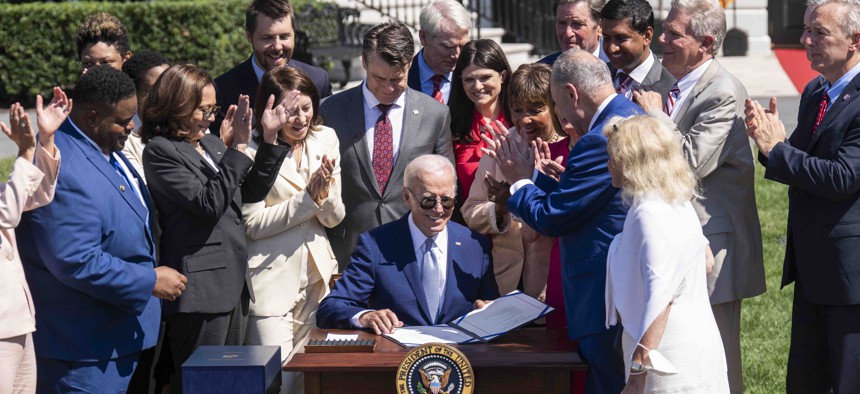Biden Signs Semiconductor Bill, Spurring Hopes for New Jobs and Manufacturing Around the US

Tom Williams/CQ-Roll Call, Inc via Getty Images Getty Images
The $54.2 billion measure drew broad support from local leaders, who believe their regions could benefit. “We need to make these chips here in America," the president said.
Calling it a “once in a generation investment in America,” President Biden on Tuesday signed into law legislation with about $50 billion worth of programs to boost the nation's semiconductor industry.
Most notably, the bipartisan bill passed by Congress last month includes $39.4 billion in subsidies to encourage companies to manufacture chips, bolstering hopes in cities around the country that it will create more jobs in their communities.
“It’s big,” Cleveland Mayor Justin Bibb told Route Fifty after attending the signing.
Even before the subsidies were created, Intel announced in January it will be spending $20 billion to build two semiconductor plants in Columbus, Ohio, which the company said would create 3,000 jobs.
With the infusion of billions more, Bibb said his city could see more jobs, not only through the construction of more plants but at the contractors the semiconductor manufacturers will need. In addition, the funding for semiconductor research in the bill is an opportunity for Case Western Reserve University and Cleveland State University in his city.
“America and its cities are stronger, and our future is more secure, thanks to this law and its investments in science and semiconductor manufacturing,” Miami Mayor Francis Suarez, president of the U.S. Conference of Mayors, said in a statement.
“These increases in research and in high-tech workforces are critical to the economic strength of cities across the country,” he said.
In addition, the White House announced it is creating an interagency permitting working group to “ensure collaboration and coordination across federal agencies, the private sector, and with state and local governments to facilitate timely and effective reviews” of the projects funded by the bill.
The President’s Council of Advisors on Science and Technology also recommended to Biden that he create a national network to train people for jobs in the semiconductor industry, including at minority-serving institutions and community colleges.
The money, Biden vowed, will restore the U.S. as a leader in the production of semiconductors, which he noted is used in everything from dishwashers to automobiles.
While the nation produced 40% of its chips in 1990, it only is creating 12% now.
“We need to make these chips here in America to bring down everyday costs and create jobs,” Biden said.
The bill has already spurred announcements by semiconductor companies that they intend to ramp up production in the U.S. Micron, a Boise, Idaho-based microchip company, announced Tuesday it will spend $40 billion on chip production in the U.S. The company said the initiative will create as many as 40,000 new jobs.
“The Micron investment will also enrich surrounding communities by bolstering education, workforce training, transportation and several other services,” the company said in a statement.
“It’s a game-changer for so many places in America and for states like mine,” Senate Majority Leader Chuck Schumer, a New York Democrat, said at the signing ceremony. “Places like Albany and Syracuse and Rochester and Buffalo and Long Island [New York] have long had the workforce, long had the ingenuity, long had shovel-ready sites. But with the Chips and Science Act, we can finally have the jobs too.
“And that’s true for all of America as well as New York,” he added.
GlobalFoundries, a semiconductor manufacturer, already has promised that if the bill passes, it would build a new computer chip factory in Saratoga County, New York, next to its existing one.
In addition, the bill will provide billions in funding for semiconductor research and workforce development. The money includes $10 billion to create semiconductor research hubs around the country, spurring hopes in college towns. For example, Purdue University in West Lafayette, Indiana, and the State University of New York at Albany, want money to create research centers.
Kery Murakami is a senior reporter for Route Fifty.
NEXT STORY: Feds Offer Greater Flexibility to Use ARPA Money for Housing






